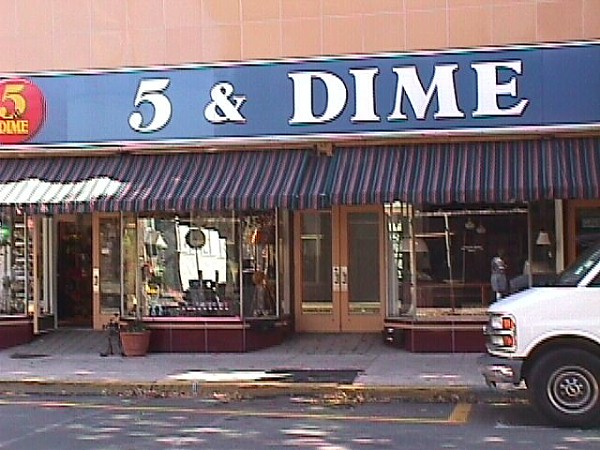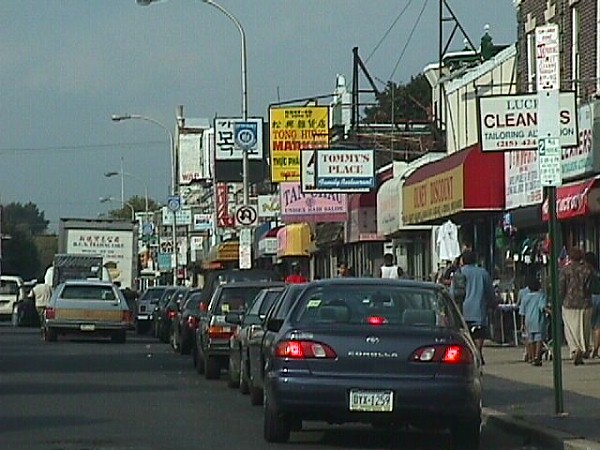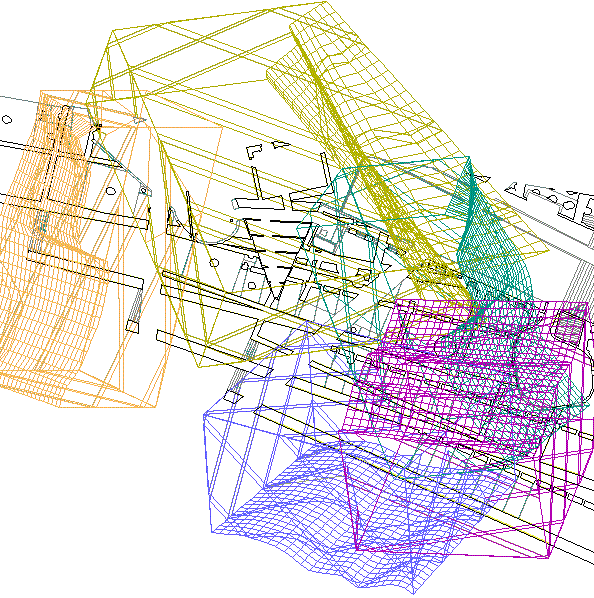2015.09.18 17:39
Architecture of Decadence
I raised the notion/question of Biometric Biosphere's relation to last century's drug culture because the image itself looks trippy and psychedelic, and it was drawn/designed in 1976. As to green architecture, survival and sustainability, those are not exactly the attributes that the image/design communicates. Sorry, but to me it looks like some sort of trippy, psychedelic utopia(n dream).
Or maybe I'm just missing to point, and the image portrays the happy workers taking a day of rest after they were busy building all those net structures the previous six days.
2015.09.20 10:48
The Midwest
I'm curious though, whether the downtowns, when they were still the only things alive, really looked all that different from one another. Like didn't every one of them have some version of a five and dime store?

Lambertville NJ 2001.10.15, but could have been Anywhere USA 50 years ago.
No doubt, however, the commercialization of the American town has been inflated.

5th Street Olney Philadelphia 2001.09.21 Is this now kind of rare in American cities, or just part of neighborhoods that are presently more known for their higher crime rate?
| |
2015.09.20 20:28
20 September


2001....remember to call out the Venturi quote flaws--so flaws lead the way to paradigm shifts?
2004....The combination of Le Corbusier, Hejduk and Izenour is indeed odd, but it might just be the perfect combination for New Wildwood architecture. Is the Bye/Gooding House a precursor?
1972...."When Modern architects righteously abandoned ornament on buildings, they unconsciously designed buildings that were ornament. In promoting Space and Articulation over symbolism and ornament, they distorted the whole building into a duck. They substituted for the innocent and inexpensive practice of applied decoration on a conventional shed the rather cynical and expensive distortion of program and structure to promote a duck; minimegastructures are mostly ducks.
It is now time to reevaluate the once-horrifying statement of John Ruskin that architecture is the decoration of construction, but we should append the warning of Pugin: It is all right to decorate construction but never construct decoration."
2014....maybe that's what later 21st century architecture will be all about--constructed eco-decoration.
| |
2015.09.20 20:31
20 September
2004.09.20 13:47
"Considered by many to be his greatest book, Michel Butor's Mobile [first published in 1962] is the result of the six months the author spent traveling across America. The text is composed from a wide range of materials, including city names, road signs, advertising slogans, catalog listings, newspaper accounts of the 1893 World's Fair, Native American writings, and the history of the "Freedomland" theme park. Butor weaves bits and pieces from these diverse sources into a collage resembling an abstract painting (the book is dedicated to Jackson Pollack) or a patchwork quilt that by turns is both humorous and quite disturbing. This "travelogue" captures--in both a textual and visual way--the energy and contradictions of American life and history."
"A gifted disciple of French anti-novelist Alain Robbe-Grillet, Butor is notable because he uses a different technique with every book and turns out intense and interesting fiction just the same." --Time
"Mobile is not only a memorable experience, accomplishing that rich task of all true art--providing the reader with new eyes--but it is also work which fellow writers and artists can profit from because it supplies the best of all ingredients: stimulation." --New York Herald Tribune
"With a lexicographer's zest for words, Butor . . . captures the tone of American clichés, suggests an almost dizzying sense of space and variety, and brings into ironic juxtaposition elements of primitiveness and sophistication that are part of the American myth." --New York Times
2015.09.21 20:57
21 September
institutional critique [sort of]
2010.09.21 15:49
I too, just last week, read of Gandy and his perspective of the Bank of England:
"Girardin's unfinished temple even today forces the observer to do a double-take. No matter how much we are prepared for it, the realization that the building is unfinished, and not a ruin, is difficult to internalize. Indeed, the attraction of such architectural indeterminacy led to a fascinating type of didactic representation in the nineteenth century that curiously links John Soane and Joseph Gandy to Violette-le-Duc and Choisy. At the beginning of this chain lies Gandy's watercolor of Soane's Bank of England exhibited at the Royal Academy in 1830. It shows the entire block Soane began working on in 1788 in a cutaway aerial perspective taken from the southeast. A storm has just passed over the building, appearing to leave in its wake a path of destruction brought to light in the ensuing calm. Bu on closer inspection, what at first seems to be a ruin is verisimilarly a projection of the site under construction."
Neil Levine, "The Architecture of the Unfinished and the Example of Louis Kahn" in Fragments: Architecture and the Unfinished (2006), p. 327.
It's interesting to note the metabolic (destructive/creative) nature of Gandy's "view." Perhaps "institutional critique" is inherently metabolic.
There are seeds of "The Architecture of the Unfinished and the Example of Louis Kahn" within Levine's earlier (1989) "Robert Venturi and "The Return of Historicism"".
2009.09.21
...hints about writing/compiling a "novel" text composed of the earlier archinect posts--all of them and somehow filling them out.
2005.09.21 16:08
I'd go to Bryn Athyn and see all the overwhelming architecture there: Bryn Athyn Cathedral, Cairnwood, Glencairn, and Cairncrest.
|